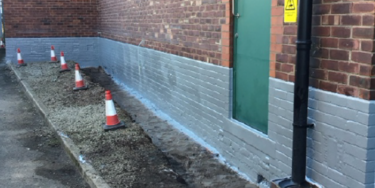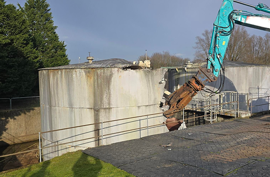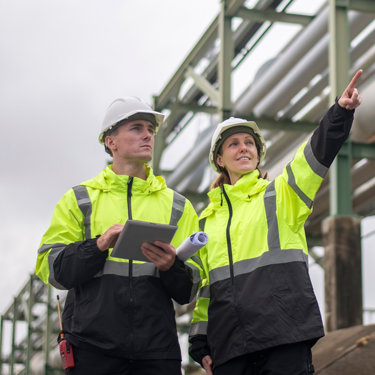Protective coatings: Safeguarding infrastructure against climate change
Published: 1 April 2025
Climate change poses significant threats to infrastructure, with increasing temperatures, extreme weather events, and rising sea levels challenging the resilience of critical assets. Protective coatings and linings play a crucial role in mitigating these impacts, ensuring longevity and reliability of your infrastructure.

Combatting corrosion and degradation
As temperatures rise and extreme weather events become more frequent, infrastructure is at greater risk of corrosion and degradation.
High temperatures can cause materials to expand and contract, leading to cracks and other forms of structural damage. These fluctuations can accelerate oxidation, a primary cause of corrosion in metals. Heavy rainfall in the UK can lead to water ingress, causing immediate damage and promoting long-term degradation through rust and mould growth.
Advanced coatings, such as polyurea and epoxy, provide a robust barrier against these elements. By preventing moisture from penetrating surfaces and lessening the impact of temperature fluctuations, they reduce the risk of corrosion and extend the lifespan of assets. For example, tank linings protect against internal corrosion, ensuring safe storage of materials and helping to prevent contamination of the products stored within.
Enhancing structural integrity
Flooding is a major consequence of climate change in the UK and causes significant damage to infrastructure.
In addition to issues with corrosion and mould growth, water ingress weakens structural integrity. This is particularly problematic in areas prone to heavy rainfall and flooding, where constant moisture exposure degrades building materials over time.
Waterproof coatings create a seamless, impermeable barrier that protects structures from water damage and against flood water contaminants and pollutants. Roof linings shield buildings from heavy rain and snow to maintain roof integrity. Polyurea application to structures provides a durable and flexible layer, allowing movement though expansion and contraction while retaining impermeability. Flood protection coatings safeguard walls, structures and contents during flood events.
Improving asset resilience
The cracks and degradation of materials caused by temperature fluctuations from heatwaves and severe winters is especially problematic for infrastructure exposed to the elements, such as concrete tanks, brick-built chambers, and industrial floors.
Specialist coatings enhance asset resilience – particularly in abrasive or corrosive environments – by providing a flexible, durable layer that withstands temperature changes and weathering. For example, industrial floor coatings offer a hard-wearing, chemical-resistant finish that protects underlying areas and improves maintenance. These coatings ensure infrastructure remains in optimal condition, reducing the need for frequent repairs and replacements.
Ensuring compliance and safety
Stricter and rapidly evolving environmental regulations (driven by climate change) mean that infrastructure must be designed and maintained with the impacts of climate change in mind to prevent environmental contamination and protect public health.
Containment solutions such as tanks, bunds, chambers, and pits provide critical defence against spills and leaks. These solutions are essential in industries like petroleum, chemical manufacturing, and wastewater treatment, where hazardous materials are frequently handled. Secondary containment areas designed to capture and manage spills from primary storage containers (e.g. tanks and drums) must be constructed or lined with materials compatible with the stored substances to prevent leaks.
Protective coatings play a vital role in enhancing the structural integrity of containment areas and preventing the release of harmful contaminants. Epoxy coatings are particularly effective due to their chemical resistance and durability, making them suitable for protecting concrete, steel, and other construction materials. Vinylester systems offer long-term protection and can withstand exposure to a wide range of chemicals, including acids, caustics, and petroleum products.
By strengthening these containment solutions with protective coatings, infrastructure can better withstand the impacts of climate change. These measures not only protect the environment but also enhance the resilience and longevity of critical infrastructure.
Essential tools in the fight against climate change
Protective coatings and linings are essential tools in the fight against climate change. By mitigating the impacts of rising temperatures and extreme weather events, these solutions ensure the resilience and longevity of critical infrastructure and help you comply with environmental regulations.
Our range of advanced coating solutions can protect and enhance your assets, helping you navigate the challenges of a changing climate. From bunds to tanks and everything in between, we can provide an optimal solution to achieve compliance through trusted containment, protect critical infrastructure from ingress or egress, and prevent corrosion or degradation to extend the life of your asset portfolio.
More from our Knowledge Hub
 Case study
Case studyPatented JBAR™ system helps Gatwick Airport mitigate impact of flooding and ensure effective containment
 News
NewsAdler & Allan acquire drainage and civil engineering experts Glanville Environmental
 Insights
InsightsTackling infiltration, misconnections and blockages to unlock hidden hydraulic capacity in wastewater networks
 Case study
Case studyDecommissioning and removal of diesel storage tanks and associated pipework
Environmental compliance today, creating a sustainable tomorrow
Helping you reduce risk to the environment and your operation by managing assets compliantly while achieving commercial, ESG, and net-zero goals.
Contact our experts



